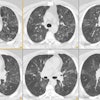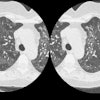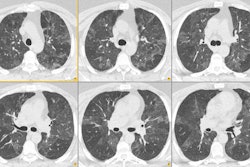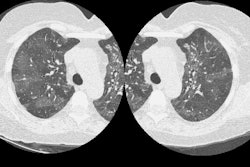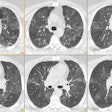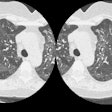Radiology 2001 Mar;218(3):695-702
Thin-section CT finding in 250 volunteers: assessment of the relationship of
CT findings with smoking history and pulmonary function test results.
Mastora I, Remy-Jardin M, Sobaszek A, Boulenguez C, Remy J, Edme JL.
PURPOSE: To evaluate the frequency and morphologic characteristics of air
trapping in volunteers with various smoking habits. MATERIALS AND METHODS: Two
hundred fifty volunteers (133 women, 117 men; mean age, 39 years), including 144
smokers, 47 ex-smokers, and 59 nonsmokers, prospectively underwent inspiratory
and expiratory high-spatial-resolution computed tomography (CT) and pulmonary
function tests (PFTs). The frequency and characteristics of air trapping were
evaluated according to the population's smoking habits and PFT results. RESULTS:
The overall frequency of air trapping was 62% (155 of 250 subjects). Lobular air
trapping was depicted in 117 (47%) of 250 subjects, without significant
differences among smokers (n = 91), ex-smokers (n = 33), and nonsmokers (n = 31)
(P =.118). Segmental and lobar air trapping (38 [15%] of 250) were more frequent
among smokers (24 [26%] of 91) and ex-smokers (nine [27%] of 33) (P <.001).
No relationship was found between air trapping and functional indexes of
small-airway disease when the CT pattern of air trapping was considered. The
strongest relationship between CT abnormalities and functional alterations at
the small-airways level was between inspiratory CT features of bronchiolitis:
ground-glass opacity, ill-defined micronodules, bronchiolectasis, and air flow
at low lung volumes. CONCLUSION: Whereas a significant relationship was observed
between segmental and lobar air trapping and cigarette consumption, lobular air
trapping was not found to reflect functional impairment at the small-airways
level.
